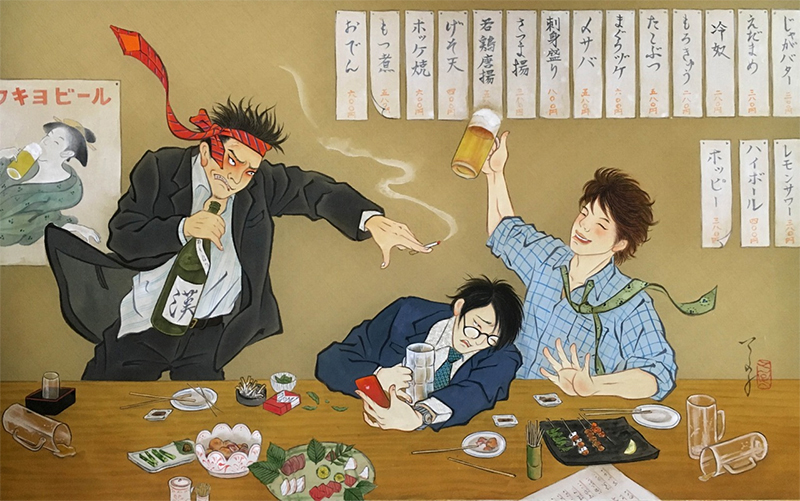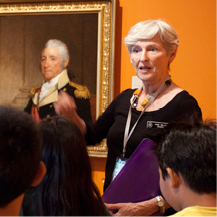
FOR IMMEDIATE RELEASE
Sept. 12, 2016
Media contacts:
Scott Whelden
Tel: 808-532-8719
Email: swhelden@honolulumuseum.org
UNIVERSITY OF HAWAI‘I AND HoMA TEAM UP FOR CONTEMPORARY JAPANESE ART SHOW
'Imayō: Japanʻs New Traditionistsʻ captures phenomenon of old traditions inspiring new art through six artistsʻ work
WHAT: Imayō: Japanʻs New Traditionists
WHEN: Oct. 2–Dec. 2, 2016
WHERE: The Art Gallery, University of Hawai‘i at Mānoa Art Building
COST: Free
INFO: 808-956-6888, hawaii.edu/art/exhibitions+events/exhibitions
(publishable)
High-res images available on request.
WHAT: Imayō: Japanʻs New Traditionists
WHEN:
Oct.
13, 2016–Jan 8, 2017; Tue-Sat 10 a.m.-4 p.m., Sun 1-5 p.m.
WHERE: Honolulu Museum of Art,
900 Beretania St.; Japan Gallery
COST:
Museum
admission $10 general, free for children age 17 and under
INFO:
532-8700,
www.honolulumuseum.org (publishable)
High-res images available on request.

Ryoko Kimura. "Three Drunks," 2016.
HONOLULU, HAWAI‘I—Japanese contemporary artists are increasingly inspired and informed by historical art and craft traditions. The Art Gallery at the University of Hawai‘i at Mānoa and the Honolulu Museum of Art team up to examine this genre with the two-venue exhibition Imayō: Japan’s New Traditionists, featuring work by the artists Tōru Ishii, Ryōko Kimura, Haruo Mitsuta, Satoshi Someya, Kōji Tanada, and Tarō Yamamoto.
Two months of programming includes a lecture by John Carpenter, curator of Japanese art at the Metropolitan Museum of Art in New York City, and workshops with artists Tōru Ishii, Ryōko Kimura, Haruo Mitsuta, and Satoshi Someya.
Exhibition curator John Szostak, who is an associate professor of Japanese art history at UHM, selected the six artists for their shared interest in the history and technical mastery of Japan’s rich pre-20th-century art and craft traditions, from painting and textiles to lacquer and wood carving.
“These works show that the past is alive and with us, not trapped in art history books,” says Szostak. “In Japan, art and craft heritage provides a focusing lens for contemporary Japanese art, alongside the influences of anime, manga, and pop culture. The artists in Imayō, in particular, share an interest in their Japanese pre-twentieth century art, but from the point of view of global contemporary artists. Although new media and digital technology offer seemingly limitless possibilities, they embrace traditional techniques and art media such as paste-resist dyeing, mineral pigments, and lacquer, simultaneously honoring this heritage and liberating it from the past with exciting new forms of contemporary expression.”
The works on view at the University of Hawai‘i and at HoMA demonstrate how cultural heritage can inspire transformational thinking, with the potential to renew and reinvigorate the familiar and conventional. The exhibition honors and transcends the confines of tradition, reflecting and commenting on Japan’s complex and often ambiguous relationship with the past. Szostak ironically references the artists’ approach in the exhibition title “Imayō,” which centuries ago was commonly used to mean “in the contemporary style,” but which sounds archaic today.
“It’s a real phenomenon right now,” says Szostak. “There are many artists in Japan who use digital technology to capture similar kinds of expression, but the commitment these artists have to learn ancient techniques interests me. They have to be much more adaptive and clever in some ways. For example, with ground pigments, there’s a limit to what you can do, and these artists find it liberating to work inside those limits.”
On view will be textiles, paintings, ceramics, lacquer wares, carved wood and cast-metal. The UH gallery will feature larger-scale works and installations.
At the Honolulu Museum of Art
Smaller works by all six artists will be on view in the Japan Gallery. The difference is they were asked to create new work inspired by historical artwork from the museum’s permanent collection. For example, Tarō Yamamoto’s 21st-century painted screen Three Drunks depicting salarymen in their cups is a direct response to the museum’s famed 18th-century hanging scroll Three Drunken Women by Torii Kiyonaga. Yamamoto even included an homage to his inspiration by placing one of Kiyonaga’s women in a poster on the bar wall.
“I like the idea of putting contemporary artworks side by side older artworks, and the works in Imayo are so good, they can hold their own in that context,” explains Szostak. He approached Shawn Eichman, Honolulu Museum of Art curator of Asian art, about doing a collaboration, and Eichman liked the idea. “Including historical works gives the show another dimension.”
With the academic strengths of the University of Hawai‘i, and HoMA's superb holdings in traditional Japanese art, "Honolulu is uniquely situated to explore the current dialogue between traditional and contemporary presented in Imayō,” says Eichman. "I was especially excited when Professor Szostak presented us with this opportunity because expanding the museum's programs in contemporary art from Asia, while building on the strengths of our historic collection, is a key part of our revised mission. This year, the museum has held exhibitions ranging from recently discovered archeological material from China to the urbanization of Edo/Tokyo as seen from the 19th century in the prints of Hiroshige to the 21st century in the post-apocalyptic imagery of Motoda Hisaharu. Visitors to the museum this fall will be able to see contemporary Japanese works not only by the artists in Imayō, but also by a leading innovative manga artist in the exhibition Visions of Gothic Angels: Japanese Manga by Takaya Miou."
The exhibition travels to Tokyo where it will be on view at the Shoto Museum of Art April 4–May 21, 2017.
This exhibition is made possible thanks to The Cooke Foundation; The Hawai‘i Council for the Humanities; The Japan Foundation; Center for Japanese Studies; Japan Studies Endowment, UHM; SEED Initiative, UHM; Student Activity and Program Fee Board, UHM; Waikiki Parc Hotel; New Otani Kaimana Beach Hotel; GalleryHNL; and anonymous donors.
Workshop: Metalwork techniques
with sculptor Haruo Mitsuta
Thursday, Sept. 29, 1:30–3 p.m.
University of Hawai‘i at Mānoa, John Young Museum of Art
Lecture: Artists of
Imayō: An Exhibition Overview, by John Szostak, professor of Japanese art
history and Imayō curator
Sunday, Oct. 2, 2–3 p.m., University of Hawai‘i at Mānoa, ART
Auditorium and The Art Gallery
Exhibition opening
reception
Sunday, Oct. 2, 3–5 p.m., University of Hawai‘i at Mānoa, The
Art Gallery
Immediately following lecture.
Artist talk: Tōru Ishii on yūzen dyeing methods
Monday, Oct. 3, 4–5 p.m.
Honolulu Museum of Art Doris Duke Theatre, 901 Kinau St.
Artist talk: Wood sculptor
Kōji Tanada
Wednesday, Oct. 5, 3–5 p.m.
University of Hawai‘i at Mānoa, John Young Museum of Art
Japanese wood sculptor Koji Tanada discusses his art and
practice.
Lecture: The Past as
Future in Japanese Contemporary Art
John Carpenter,
curator of Japanese Art, Metropolitan Museum of Art
Friday, Oct. 14, 5:30–7 p.m.
University of Hawai‘i at Mānoa, ART Auditorium
Artist talk: Painter
Ryōko Kimura on East Asian mineral pigments and their use
Thursday, Oct. 20, 3–4:30 p.m.
University of Hawai‘i–Mānoa, John Young Museum of Art
Artist talk: Satoshi
Someya on lacquer arts and the lacquering process
Friday, Oct. 21, 3–4:30 p.m., University of Hawai‘i–Mānoa,
Art Building, room 101
Lecture: Japanese Painting
and the Western Gaze: Notes from the 19th Century
Chelsea Foxwell, professor
of Japanese Art History, University of Chicago
Thursday, Nov. 10, 3–5 p.m.
University of Hawai‘i–Mānoa, Moore Hall, room 319 (Tokioka
Room)
Lecture: Kōjutsu: ʻFine Techniqueʻ in Contemporary Japanese Art
Tsutomu Ikeuchi,
curator and owner of Roentogenwerke Art Gallery, Tokyo
Tuesday, Nov. 22, 5–6:30 p.m.
University of Hawai‘i–Mānoa, Art Building, room 101
Workshop: The use of East Asian mineral pigments by painter Tarō Yamamoto
Tuesday, Nov. 29, 3:30–5 p.m.
University of Hawai‘i at Mānoa, Art Building, room 314
Round-table discussion:
Tradition: Whatʻs the use?
Wednesday, Nov. 30, 3:30–5 p.m.
Honolulu Museum of Art, Doris Duke Theatre
Participants: Glenn Adamson, craft theorist and former
director of the Museum of Arts And Design, NYC; Jaimey Hamilton-Faris,
professor of Critical Theory and Contemporary Art, UH Mānoa; Tarō Yamamoto,
painter and professor of Fine Arts, Akita University of Art
-end-
To UNSUBSCRIBE, please click here.
To join, e-mail lgriffith@honolulumuseum.org , or call (808) 532-6091.
About the Honolulu Museum of Art
One of the world’s premier art museums, the Honolulu Museum of Art presents international caliber special exhibitions and features a collection that includes Hokusai, van Gogh, Gauguin, Monet, Picasso and Warhol, as well as traditional Asian and Hawaiian art.
Located in two of Honolulu’s most beautiful buildings, visitors enjoy two cafés, gardens, and films and concerts at the theater. The museum is dedicated to bringing together great art and people to create a more harmonious, adaptable, and enjoyable society in Hawai’i.
Locations:
Honolulu Museum of Art: 900 S. Beretania Street
Honolulu Museum of Art Spalding House: 2411 Makiki Heights Drive
Honolulu Museum of Art School: 1111 Victoria Street
Honolulu Museum of Art at First Hawaiian Center: 999 Bishop Street
Honolulu Museum of Art Doris Duke Theatre: 901 Kinau Street (at rear of museum)
Website: www.honolulumuseum.org
Phone: 808-532-8700
Hours:
Honolulu Museum of Art: Tues–Sat 10 am–4:30pm; Sun 1–5 pm; closed Monday.
Honolulu Museum of Art Spalding House: Tues–Sat 10am–4pm; Sun noon–4pm
Admission (permits entry to both museums on the same day):
$10 general admission; children 17 and under are free.
There’s a lot happening at the Museum!
![]()
![]()
![]()
![]()
Unsubscribe | Forward | View in browser
You are receiving this email because of your interest in the Honolulu Museum of Art.
Honolulu Museum of Art 900 S Beretania St Honolulu, HI 96814


